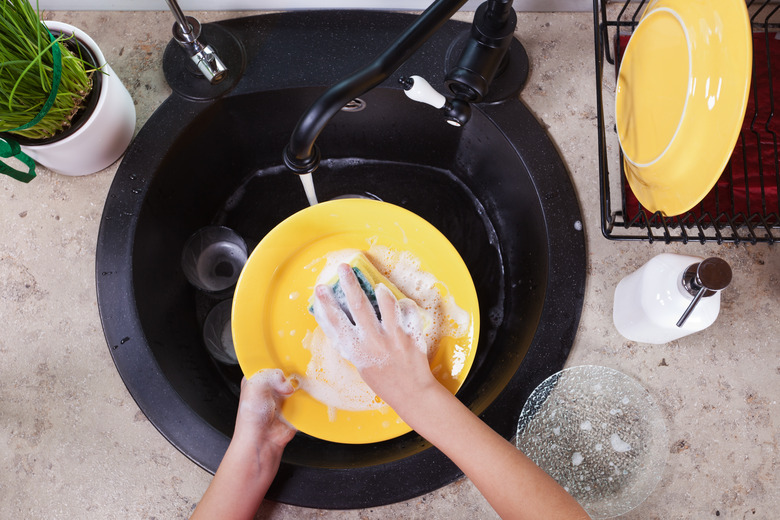How To Sanitize Dishes With Bleach
While washing dishes by hand will make them relatively clean, it doesn't sanitize them. Sanitizing kills many of the types of germs that may otherwise spread or potentially cause illness. Washing dishes with bleach and water after they're already clean sanitizes them.
Wash Dishes With Soap First
Wash Dishes With Soap First
In order to sanitize dishes, the dishes have to be visibly clean. Hand wash the dishes in a sink with warm to hot tap water and a few squirts of dish soap. Use a clean dishcloth to wash each dish. A sponge isn't a good tool for this task, as sponges tend to house germs that can spread to the items you're washing. After washing the dishes, rinse them in hot water, then allow them to air dry.
Clorox Bleach Method
Clorox Bleach Method
Clorox recommends using 2 tablespoons Clorox bleach per gallon of water in a clean sink. Any brand of unscented chlorine bleach will do; the scented varieties aren't meant for use on items that touch food.
If your sink is made of stainless steel, use a clean plastic tub placed inside the sink basin when sanitizing dishes, as any brand of household bleach can damage stainless steel. Use only cool or lukewarm water for your sanitizing solution, as hot water can stop bleach from properly sanitizing the dishes. Soak glassware and dishes for two minutes in the solution, then remove the items while wearing rubber gloves. Allow the dishes to air dry.
Note: Don't try to save time by adding bleach to soapy dishwater. Bleach and dish soap shouldn't be used at the same time, as the soap will render the bleach ineffective.
Achieving the Proper Bleach Ratio
Achieving the Proper Bleach Ratio
The amount of bleach in the water should be 200 parts per million. Minerals in the water could affect the ratio over time. To ensure proper sanitation, use chlorine test strips, which are available at any shop that sells pool supplies. If you're sanitizing a lot of dishes, test the water after you've sanitize some to ensure there's enough chlorine in the water, as chlorine quickly loses its effectiveness. If more bleach is needed, start with a fresh batch of water and chlorine bleach.
Sanitizing With Hot Water
Sanitizing With Hot Water
Metal items, such as utensils, pots and pans, shouldn't be sanitized with bleach, as bleach may react with the metal and darken it. Instead, boil small metal items in hot water for 10 minutes, as a bath in extremely hot water is enough to kill many pathogens. For pots and pans, just boil water in the pan for several minutes.
A dishwasher with a heat-dry setting is also hot enough to sanitize dishes in most cases. If your dishwasher has a "sanitize" setting, select that option for your next load of dishwasher-safe materials. For yet another way to sanitize with hot water, soak dishware in water that's at least 170 degrees Fahrenheit for at least 30 seconds. Use a candy thermometer to get a temperature reading on the water to ensure accuracy.
Don't dip your hands into the hot water you used to sanitize dishes, as it may scald. Instead, wait until the water cools or work with a plastic tub set inside the sink and gently tip the tub away from you to release the water into the drain once the water cools a little.
References
- Cooking Light: This is the Best Way to Wash Dishes By Hand
- Center for Disease Control and Prevention: Cleaning and Sanitizing with Bleach
- Clorox: Sanitizing Dishes Using Bleach
- Stop Foodborne Illness: How to Clean, Sanitize and Disinfect
- Michigan State University Extension: Clean, Sanitize and Disinfect
- Ruvati: How do I Clean My Stainless Steel Sink?
